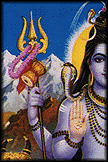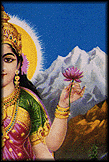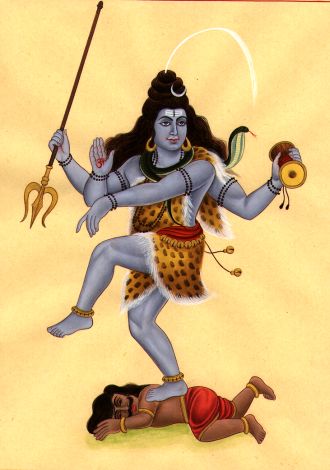

The God and the Goddess are the first self-relevation of the Absolute, the male being the personification of the passive aspect, Eternity, the female of the activation enery, the dynamism of Time. Though aparantly opposites, they are in essence one. The Goddess is the yoni, mother-womb of the ever-cycling eons, of all the universes endlessly extending in space, of every atom in the living cell. She is called "The Universal Power", "The Fairest of the Three Worlds", she has been known in myth as Uma, Durga, Kali, Chamunda, Gauri, Haimavathi, Vindhyavaini. She has her living counterpart in every woman, as the God in every man. Shiva-Shakti images symbolize Life, both universal life and individual, as an incessant interaction of cooperating opposites
 Shiva, the lord of the lingam, the consort of Shakti-Devi, also is Nataraja, "King of Dancers." Dance used to be a form of magic and helps one develop special powers. Like yoga, the dance induces trance, ecstasy, the experience of the divine, the realization of one's own true nature, and, finally, mergence into the divine essence. The dance is an act of creation. It brings about a new situation and summons the dancer a new and higher personality. It has a cosmogenic function, in that it arouses dormant energies which then may shape the world. On a universal scale, Shiva is the Cosmic Dancer; in his "Dancing Manifestation" he embodies himself and simultaneously gives manifestation to Eternal Energy. The forces gathered and projected in his frantic, ever-enduring gyration, are the powers of the evolution, maintenance, and dissolution of the world. Nature and all its creatures are the effects of his eternal dance. In his upper left hand is a drum, shaped like an hourglass, for the beating of the rhthym. This connotes Sound, the vehicle of speech, the conveyer of revelation, tradition, incantation, magic, and divine truth. Furthermore, Sound is associated in India with Ether, the first of the five elements. Ether is the primary and most subtly pervasive manifestation of the Divine Substance. Out of it unfold all the other elements, Air, Fire, Earth, and Water. Together therefore Sound and Ether signify the first, truth pregnant moment of creation, the productive energy of the Absolute, in its pristine cosmogenic strength. His lower right hand bears on its palm a tongue of flame. Fire is the element of the destruction of the world. At the close of Kali Yuga(our present age), Fire will annihilate the body of creation, to be itself then quenched by the ocean of the void. Here in the balance of the hands is illustrated a counterpoise of creation and destruction in the play of the cosmic dance. As a ruthlessness of opposites, the Transcendental shows through the mask of the enigmatic Master: ceaseless production against an insatiate appetite of extermination, Sound against Flame. And the field of terrible interplay is the Dancing Ground of the Universe, brilliant and horrific with the dance of the god. Shiva is dancing on the prostrate body of a dwarfish demon. This is "The Man or Demon called Forgetfulness, or Heedlessness." It is symbolic of life's blindness, man's ignorance. Conquest of this demon lies in the attainment of true wisdom. Therein is release from the bondages of the world. All these things are made manifest, simultaneously with the pulse of every moment, and in sequence through the changes of time.
Shiva, the lord of the lingam, the consort of Shakti-Devi, also is Nataraja, "King of Dancers." Dance used to be a form of magic and helps one develop special powers. Like yoga, the dance induces trance, ecstasy, the experience of the divine, the realization of one's own true nature, and, finally, mergence into the divine essence. The dance is an act of creation. It brings about a new situation and summons the dancer a new and higher personality. It has a cosmogenic function, in that it arouses dormant energies which then may shape the world. On a universal scale, Shiva is the Cosmic Dancer; in his "Dancing Manifestation" he embodies himself and simultaneously gives manifestation to Eternal Energy. The forces gathered and projected in his frantic, ever-enduring gyration, are the powers of the evolution, maintenance, and dissolution of the world. Nature and all its creatures are the effects of his eternal dance. In his upper left hand is a drum, shaped like an hourglass, for the beating of the rhthym. This connotes Sound, the vehicle of speech, the conveyer of revelation, tradition, incantation, magic, and divine truth. Furthermore, Sound is associated in India with Ether, the first of the five elements. Ether is the primary and most subtly pervasive manifestation of the Divine Substance. Out of it unfold all the other elements, Air, Fire, Earth, and Water. Together therefore Sound and Ether signify the first, truth pregnant moment of creation, the productive energy of the Absolute, in its pristine cosmogenic strength. His lower right hand bears on its palm a tongue of flame. Fire is the element of the destruction of the world. At the close of Kali Yuga(our present age), Fire will annihilate the body of creation, to be itself then quenched by the ocean of the void. Here in the balance of the hands is illustrated a counterpoise of creation and destruction in the play of the cosmic dance. As a ruthlessness of opposites, the Transcendental shows through the mask of the enigmatic Master: ceaseless production against an insatiate appetite of extermination, Sound against Flame. And the field of terrible interplay is the Dancing Ground of the Universe, brilliant and horrific with the dance of the god. Shiva is dancing on the prostrate body of a dwarfish demon. This is "The Man or Demon called Forgetfulness, or Heedlessness." It is symbolic of life's blindness, man's ignorance. Conquest of this demon lies in the attainment of true wisdom. Therein is release from the bondages of the world. All these things are made manifest, simultaneously with the pulse of every moment, and in sequence through the changes of time.